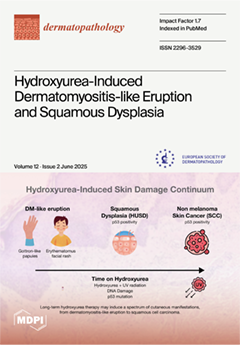Open AccessArticle
Cutaneous Metastases—Histological Particularities of Multifaceted Entities
by
Andreea Cătălina Tinca, Bianca Andreea Lazar, Andreea Raluca Cozac-Szőke, Georgian Nicolae Radu, Simina Petra Simion, Diana Maria Chiorean, Irina Bianca Kosovski, Adrian Horațiu Sabău, Raluca Niculescu, Iuliu Gabriel Cocuz, Raluca-Diana Hagău, Emoke Andrea Szasz, Sabin Gligore Turdean and Ovidiu Simion Cotoi
Cited by 1 | Viewed by 2081
Abstract
Cutaneous metastases from internal organ cancers are diagnosed in approximately 0.2% of skin biopsies. This diagnosis can be the first sign of a previously undiagnosed malignancy with an internal organ origin. We conducted a retrospective study that included all cases of cutaneous metastases
[...] Read more.
Cutaneous metastases from internal organ cancers are diagnosed in approximately 0.2% of skin biopsies. This diagnosis can be the first sign of a previously undiagnosed malignancy with an internal organ origin. We conducted a retrospective study that included all cases of cutaneous metastases diagnosed in our hospital. A total of 25 patients were identified (14 females and 11 males). The average age of the patients included was 62.3. The most common primary cancer site was the lung for male patients, while for female patients it was the breast. In seven of our cases, cutaneous metastases were the first sign of an internal organ cancer. Common sites for cutaneous metastases in our study involved the anterior thoracic wall, the abdomen, and the scalp. Our study aims to highlight the importance of recognizing the histopathology of metastatic tumors and differentiating them from primary skin neoplasms. Immunohistochemistry is a mandatory tool for differential diagnosis in all cases, especially for patients who do not have a history of neoplasia.
Full article
►▼
Show Figures





